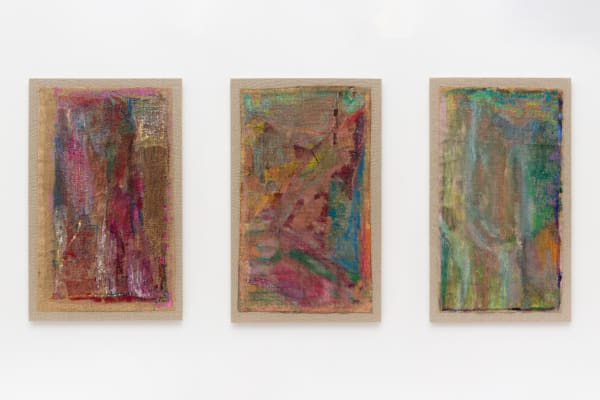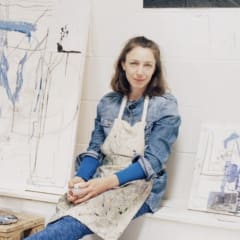Varda Caivano Varda Caivano
Past exhibition
Overview
Mendes Wood DM São Paulo is pleased to present Varda Caivano's first exhibition at the gallery’s Sao Paulo space. The exhibition brings together recent paintings andexplores the artist's evolving practice of abstraction.
Caivano investigates moments of light and image, almost like an archeologist exploring fossilized rocks. Her work is at once mysterious and same time persistent and timeless. In the exercise of combining and juxtaposing colors and shapes, Caivano work is ameditation on the nature of her own paintings. One of the possible ways to unlock our understanding of Caivano's work is to consider the image as essence, without the artifices commonly attributed to painting. It is as if we are facing what is behind it.
When exploring the image's essential quality, the process of experiencing the exhibitioncan reveal specific psychoanalytical characteristics of the observer – The demand forquestions rather than answers is well defined in its structure, and it is like aninvestigation of effects over causes – and their relationship to the paintings. It is as ifher painting questioned the origin of the world or simply the origin of our own observation.
This examination is both radical and silent. The oil and coal on the jute suggestresistance but at the same time strive towards a kind of balance. The virtuously peculiar relationship between painting, jute, and the fabrics in the frame suggest a look outsidethe painting at the same time that takes the viewer into it, a dichotomy of ways to lookat the painting. The sensitivity of Caivano's body of work finds urgency in her method. The artist paints her images from the inside to the outside.
They are negative of what can be understood in painting. It is the state of the beginningbut also of the end of the light. It causes an involuntary anomaly in time, in the sameway that poetry does. By exploring a rhythm marked by the gesture preceding the form, Caivano provides alternatives for the painting to suggest an essence above its image. When using the image as a tool to access subjectivity, the artist aligns her way with apoet's method, which uses words to abstract language. They are rhythmic noises thatforce us to look inward, for what is buried – for the origin.
Varda Caivano (1971, Buenos Aires) lives and works in London.
Recent solo shows include the Renaissance Society, Chicago (2015); Chisenhale gallery,London (2007) and Kunstverein Freiburg, (2006). In 2013 a concise presentation of paintings throughout Caivano's practice, from early career to her most recent work, wasincluded in The Encyclopedic Palace, the 55th International Art Exhibition of the Venice Biennale, selected by curator Massimiliano Gioni. Other recent exhibitions Varda Caivano, Tomio Koyama Gallery, Tokyo, Japan (2019); Surface Work,Victoria Miro, London, UK (2018); Collection 2: The 1980s Zeitgeist as a Point of Departure, The National Museum of Art, Osaka, Japan (2018). Current groupexhibitions include No horizon, no edge to liquid, Zabludowicz Collection, London, UK (16 Jan 2020 - 23 Feb 2020) and Slow Painting, organised by Hayward Touring,which originated at Leeds Museum and Art Gallery, UK, touring to The LevinskyGallery, Plymouth, UK (24 Jan – 28 Mar 2020), The Edge, University of Bath and BathSpa School of Art and Design (10 April–6 June 2020) and Inverness Museum and ArtGallery, and Thurso Art Gallery (24 July–3 October 2020). A solo exhibition will takeplace at Hastings Contemporary, Hastings, UK, in 2021.
Caivano investigates moments of light and image, almost like an archeologist exploring fossilized rocks. Her work is at once mysterious and same time persistent and timeless. In the exercise of combining and juxtaposing colors and shapes, Caivano work is ameditation on the nature of her own paintings. One of the possible ways to unlock our understanding of Caivano's work is to consider the image as essence, without the artifices commonly attributed to painting. It is as if we are facing what is behind it.
When exploring the image's essential quality, the process of experiencing the exhibitioncan reveal specific psychoanalytical characteristics of the observer – The demand forquestions rather than answers is well defined in its structure, and it is like aninvestigation of effects over causes – and their relationship to the paintings. It is as ifher painting questioned the origin of the world or simply the origin of our own observation.
This examination is both radical and silent. The oil and coal on the jute suggestresistance but at the same time strive towards a kind of balance. The virtuously peculiar relationship between painting, jute, and the fabrics in the frame suggest a look outsidethe painting at the same time that takes the viewer into it, a dichotomy of ways to lookat the painting. The sensitivity of Caivano's body of work finds urgency in her method. The artist paints her images from the inside to the outside.
They are negative of what can be understood in painting. It is the state of the beginningbut also of the end of the light. It causes an involuntary anomaly in time, in the sameway that poetry does. By exploring a rhythm marked by the gesture preceding the form, Caivano provides alternatives for the painting to suggest an essence above its image. When using the image as a tool to access subjectivity, the artist aligns her way with apoet's method, which uses words to abstract language. They are rhythmic noises thatforce us to look inward, for what is buried – for the origin.
Varda Caivano (1971, Buenos Aires) lives and works in London.
Recent solo shows include the Renaissance Society, Chicago (2015); Chisenhale gallery,London (2007) and Kunstverein Freiburg, (2006). In 2013 a concise presentation of paintings throughout Caivano's practice, from early career to her most recent work, wasincluded in The Encyclopedic Palace, the 55th International Art Exhibition of the Venice Biennale, selected by curator Massimiliano Gioni. Other recent exhibitions Varda Caivano, Tomio Koyama Gallery, Tokyo, Japan (2019); Surface Work,Victoria Miro, London, UK (2018); Collection 2: The 1980s Zeitgeist as a Point of Departure, The National Museum of Art, Osaka, Japan (2018). Current groupexhibitions include No horizon, no edge to liquid, Zabludowicz Collection, London, UK (16 Jan 2020 - 23 Feb 2020) and Slow Painting, organised by Hayward Touring,which originated at Leeds Museum and Art Gallery, UK, touring to The LevinskyGallery, Plymouth, UK (24 Jan – 28 Mar 2020), The Edge, University of Bath and BathSpa School of Art and Design (10 April–6 June 2020) and Inverness Museum and ArtGallery, and Thurso Art Gallery (24 July–3 October 2020). A solo exhibition will takeplace at Hastings Contemporary, Hastings, UK, in 2021.
Works
-
 Varda Caivano, Untitled, 2020
Varda Caivano, Untitled, 2020 -
 Varda Caivano, Untitled, 2020
Varda Caivano, Untitled, 2020 -
 Varda Caivano, Untitled, 2020
Varda Caivano, Untitled, 2020 -
 Varda Caivano, Untitled, 2020
Varda Caivano, Untitled, 2020 -
 Varda Caivano, Untitled, 2020
Varda Caivano, Untitled, 2020 -
 Varda Caivano, Untitled/ Sem título, 2020
Varda Caivano, Untitled/ Sem título, 2020 -
 Varda Caivano, Untitled, 2020
Varda Caivano, Untitled, 2020 -
 Varda Caivano, Untitled, 2020
Varda Caivano, Untitled, 2020 -
 Varda Caivano, Untitled, 2020
Varda Caivano, Untitled, 2020 -
 Varda Caivano, Untitled, 2020
Varda Caivano, Untitled, 2020 -
 Varda Caivano, Untitled, 2020
Varda Caivano, Untitled, 2020 -
 Varda Caivano, Untitled, 2020
Varda Caivano, Untitled, 2020 -
 Varda Caivano, Untitled, 2020
Varda Caivano, Untitled, 2020 -
 Varda Caivano, Untitled, 2020
Varda Caivano, Untitled, 2020
Installation Views
















